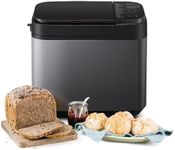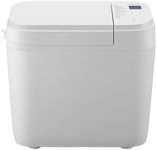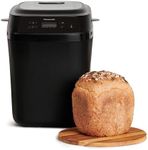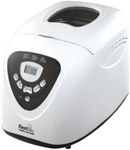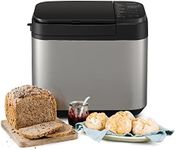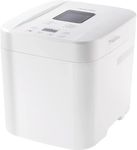Buying Guide for the Best Bread Maker
Choosing the right bread maker can transform your kitchen experience, allowing you to enjoy fresh, homemade bread with ease. When selecting a bread maker, consider your baking needs, the types of bread you want to make, and the features that will make the process convenient and enjoyable for you. Understanding the key specifications will help you make an informed decision that suits your lifestyle and preferences.Loaf SizeLoaf size refers to the weight of the bread that the machine can produce in one baking cycle. This is important because it determines how much bread you can make at once. Bread makers typically offer loaf sizes ranging from 1 pound to 2.5 pounds. If you have a small household or prefer fresh bread daily, a smaller loaf size might be sufficient. For larger families or if you like to bake in bulk, a machine that can handle larger loaf sizes would be more appropriate.
Programs and SettingsPrograms and settings in a bread maker refer to the pre-set options that control the baking process, such as kneading, rising, and baking times. These are important because they offer versatility and convenience, allowing you to make different types of bread, such as whole wheat, gluten-free, or even dough for pizza. Basic models may have a few settings, while more advanced ones offer a wide range of options. Consider what types of bread you plan to make and choose a machine with the appropriate settings to match your baking ambitions.
Timer and Delay StartThe timer and delay start feature allows you to set the bread maker to start baking at a later time. This is important for those who want to wake up to fresh bread or have it ready when they return home from work. Typically, delay timers can be set for up to 13 hours. If you have a busy schedule and want the flexibility to have fresh bread at a specific time, look for a bread maker with a reliable delay start function.
Crust ControlCrust control allows you to choose the darkness of the bread's crust, ranging from light to dark. This feature is important for personalizing your bread to your taste preferences. If you enjoy experimenting with different textures or have a specific preference for crustiness, a bread maker with adjustable crust settings will be beneficial. Consider how important crust texture is to you when selecting a model.
Kneading PaddlesKneading paddles are the components that mix and knead the dough inside the bread maker. The design and number of paddles can affect the texture and consistency of the bread. Some machines come with a single paddle, while others have dual paddles for more thorough kneading. If you plan to make a variety of bread types or want a more uniform texture, consider a model with dual paddles. Additionally, some paddles are collapsible or removable to minimize the hole left in the bottom of the loaf.
Size and DesignThe size and design of a bread maker refer to its physical dimensions and aesthetic appeal. This is important if you have limited counter space or want the appliance to match your kitchen decor. Bread makers come in various sizes, so measure your available space and consider how often you'll be moving the machine. If you plan to keep it on the counter, choose a design that complements your kitchen style.

